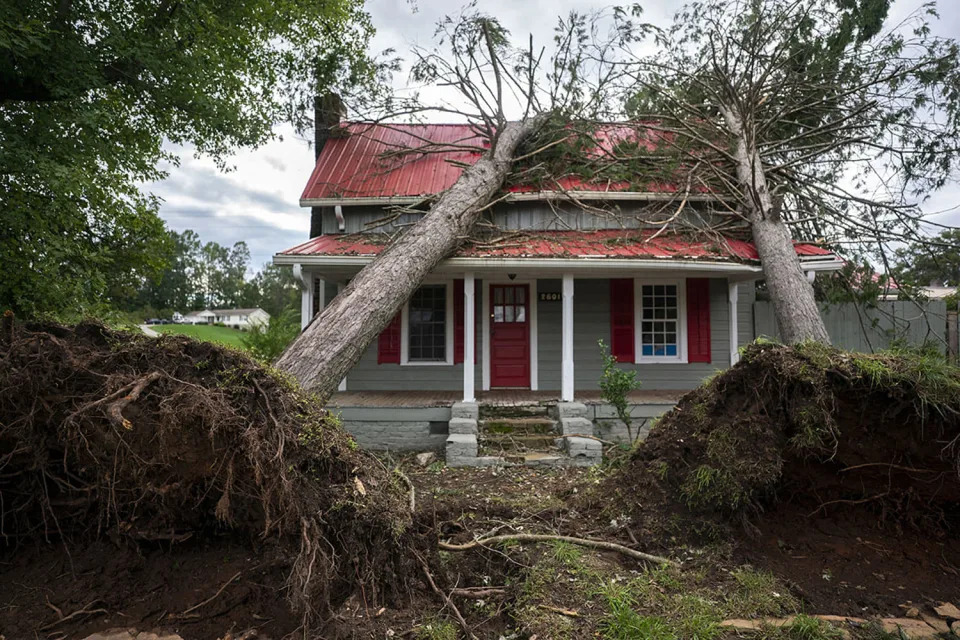Asheville and its surrounding towns in western North Carolina had just been soaked by a severe rainstorm when the remnants of Hurricane Helene slammed into the Blue Ridge Mountains.
What unfolded, starting Wednesday evening and lasting through the weekend, is a well-studied atmospheric phenomenon.
“As weather moves in toward the mountains, the clouds have to rise up and over the mountains, and that’s the upslope effect,” said Doug Outlaw, a National Weather Service meteorologist in the agency’s office in Greenville-Spartanburg, South Carolina. “It tends to squeeze out more rainfall, and unfortunately, it caused extreme flash flooding, which devastated communities. It was a huge amount of water at one time being channeled and funneled through the valleys.”
The devastation in North Carolina’s inland mountain towns — thousands of feet in elevation and hundreds of miles from any coastline — may seem unexpected for an area once thought of as a safe haven from the effects of climate change, but it’s the type of far-reaching impact that will become increasingly likely, experts say.
Helene inundated parts of southern Appalachia with well over 2 feet of rain. Floodwaters carried away entire houses and washed out highways, cutting off access to towns.
“That’s about a half-year’s worth of rain coming in four days,” Outlaw said. “It’s one of the worst weather events that’s hit this area in history.”
At least 20 locations in western North Carolina, including Asheville, experienced levels of flooding expected only once every 1,000 years.
Climate change is intensifying storms because higher ocean temperatures act as fuel and a warmer atmosphere allows for heavier rain over land. For every 1 degree Fahrenheit of warming, the atmosphere can hold about 4% more moisture, said Shel Winkley, a meteorologist at the nonprofit research group Climate Central.
That significantly increases the chance of catastrophic flooding.
A report from Climate Central in May detailed the increasing risk of inland flooding as a result of global warming. The places where remnants of Helene caused the most damage were among those the report identified as most at risk.
“Appalachia was named as one of the areas that had an outsized burden for future flooding,” Winkley said. “This is an area that’s known to have the potential for more flood events and more costly flood events, as well. Unfortunately, that’s what we saw this past weekend.”
Flooding in Asheville, N.C., on Saturday.
Of the more than 120 storm-related deaths across six states recorded so far, at least 44 were in North Carolina.
Part of the problem is the region’s mountainous terrain. But in this case, the area was dealt a double whammy: Heavy rain fell days before Hurricane Helene made landfall in Florida, then remnants of the storm brought more rain and wind to southern Appalachia.
“It was two compounding events that clashed,” Winkley said.
Forecasters saw it coming with a high degree of accuracy.
“*URGENT MESSAGE* This will be one of the most significant weather events to happen in the western portions of the area in the modern era,” officials with the Greenville-Spartanburg office of the National Weather Service wrote in an update on X on Thursday. “Record flooding is forecasted and has been compared to the floods of 1916 in the Asheville area.”
In 1916, 25 people died when floodwaters swept away buildings, destroyed the local power plant, ruined the railroad and cut Asheville off from the rest of the country, according to the Asheville Museum of History.
The similarities are striking.
“The forecast was really, really good,” said Christopher Godfrey, chair of the department of atmospheric sciences at the University of North Carolina Asheville. “The National Weather Service did a fantastic job. They were appropriately firm in their choice of words.”
Given those warnings and his own expertise, he said, the horrific outcome was no surprise to him.
“It’s the topography around here. There’s some really steep terrain. Houses are built on steep terrain. Roads go up steep terrain,” Godfrey said. “This is such a catastrophic flood with all the rain we got. Even well-constructed bridges are going to be gone.”
Scientists are exploring what role climate change played in Hurricane Helene and have shared some early results. One group found Helene was up to 20% wetter in parts of the Southeast as a result of global warming. Another estimated that climate change caused some parts of Georgia and the Carolinas to get 50% more rain and that the rainfall totals were made up to 20 times more likely because of climate change. The estimates are preliminary, but both rely on respected scientists using methods that have been peer-reviewed previously.
Godfrey recorded 13.37 inches of rain at his house in Arden, North Carolina, over three days. More than 21 inches fell over the same period in nearby Hendersonville, according to the National Weather Service. That’s simply too much for the mountainous landscape — the flood damage in Godfrey's area corresponds roughly to what Federal Emergency Management Agency maps suggest would happen in a flood expected once every 500 years.
A storm-damaged house Monday in Old Fort, N.C.
The severity caught one of his neighbors off-guard, Godfrey said.
“The neighbor across the street said: ‘I heard that, but I didn’t do anything. I didn’t think it would be that bad.’”
Godfrey said a few consequences of the storm have been surprising, including the level of damage to trees, which have snarled roads and made first responders’ jobs extra challenging.
“I don’t think anyone expected the extent of the tree fall,” said Godfrey, who researches wind storms and tree falls.
He thinks most trees toppled because the soil was so saturated. During the height of the storm, Godfrey said, he heard a pattern ringing throughout the neighborhood as one tree fell after another.
“You could hear snap, snap, snap, snap and then hear the crash when it lands,” Godfrey said. “What we heard was the roots snapping.”
Downed trees on a home in Rutherfordton, N.C., on Sunday.
Two walnut trees, taller than 100 feet, fell a few dozen feet from Godfrey’s home. Another tree crunched a neighbor’s car.
Communication systems have also fared worse than Godfrey expected.
“We have no idea what’s going on out there,” Godfrey said in a phone interview during a visit to a weather station he manages at UNC Asheville. “The only reason you got me is I’m on top of a hill looking over Asheville at the moment. Down in the valley, there’s no internet, no Wi-Fi, no cellular and even no texting.”
Asheville had been dubbed a climate haven in some news coverage, given that it’s removed from coastal threats like sea level rise and its relatively high elevation keeps temperatures down.
But almost nowhere on Earth is insulated from natural hazards, and few places have taken steps to sufficiently prepare for extreme weather that is becoming more common. Seattle was once viewed as a potential climate haven, until a 2021 heat wave sent temperatures to 108 degrees Fahrenheit in a place where most people didn’t have air conditioning. And parts of the Midwest that were seen as climate havens have seen extreme rain, too.
“Climate change hits different communities in different ways, and so while mountainous areas may have been a haven from extreme temperatures, as we found out, they’re not necessarily a haven from the potential for devastating flooding,” Winkley said.
People wait in line to pump gas Sunday in Fletcher, N.C.
It’s a reminder, he said, of the far-ranging consequences of a warming world.
“A hurricane is normally thought of as a coastal problem, but now we’re finding that these events — these big-ticket, climate-driven events — can make weather more intense farther away from the typical impact spots that you would think,” he said.
This article was originally published on NBCNews.com

 German (DE)
German (DE)  English (US)
English (US)  Spanish (ES)
Spanish (ES)  French (FR)
French (FR)  Hindi (IN)
Hindi (IN)  Italian (IT)
Italian (IT)  Russian (RU)
Russian (RU)  6 hours ago
6 hours ago

























Comments